Author: jk, Odaily Planet Daily
As the global cryptocurrency infrastructure gradually matures, users' demand for the "real-world usability" of on-chain assets is also increasing. However, how to truly utilize on-chain assets in real life has always been a concern for crypto users.
Crypto payment cards (also known as "U cards") have quietly emerged in this context—they not only bridge the "last mile" of asset usage but also subtly reshape people's understanding of wallets, PayFi, and payment networks.
Whether it's directly linking mobile payment apps for consumption or flexibly responding to market conditions by collateralizing Bitcoin to borrow stablecoins, the ways to use crypto payment cards are becoming increasingly diverse. Among them, some are based on exchanges, focusing on stability and cashback rewards, while others are based on wallets or protocols, emphasizing on-chain native assets and composability. Today's crypto payment cards have become a practical and increasingly mature entry point into crypto finance.
To clarify the real user experiences and differences of such products, Odaily Planet Daily has conducted an in-depth analysis of the ten most representative crypto payment cards in the current market, including Bybit, Bitget, SafePal, Morph, Infini, Coinbase, Nexo, MetaMask, 1inch, and RedotPay. This analysis combines their application thresholds, supported assets, fee structures, cashback mechanisms, and on-chain interaction capabilities, providing a systematic overview and horizontal comparison to help readers find the most suitable "pass" for themselves in this rapidly evolving field.
Newbie U Cards Suitable for Chinese Users
Bybit Card: The Most Widely Used Exchange U Card
The virtual debit card recently launched by Bybit has gained popularity on social media due to its no annual fee and low threshold features. This card supports KYC certification for mainland China, and the application process is free.
The application process is quite simple: users first need to register a Bybit account, and after completing the registration, they must undergo real-name authentication on the platform. It is reported that users with mainland Chinese identities can pass the KYC review. Once certified, users can find the "Card" option on the homepage to enter the application page, where they can choose different regions to open the card:
If users select Australia as the card opening region, there is no need to provide address proof for applying for a virtual card. After submitting the application, the review time is approximately 5 to 7 working days. In this version, the default currency of the card is USD.
Users can also choose the European Economic Area (EEA), but it is important to note that the EEA version requires proof of address in the European Economic Area, such as utility bills or credit card statements from a European address. In this version, the default currency of the card is Euro.
In terms of usage, the card can be managed within the Bybit App, and the virtual card can be directly linked to Apple Pay, Google Pay, etc., and can be used at merchants worldwide that support Mastercard.
Recent news on Twitter indicates that the Australian version of the virtual card can no longer be linked to Alipay and WeChat Pay for consumption, mainly due to cashback activities being excessively exploited by certain groups. However, some users have reported that Alipay's tap-to-pay feature can still be used for transactions, which may vary depending on each user's account risk control. If users need to link these payment tools, they might consider applying for the Euro card version, as per Twitter information, the Euro card version can still be linked to Alipay and used normally.
In terms of fees, the Bybit card is quite competitive: transaction fees range from 0.9% to 3%, depending on the card opening region, transaction currency, and consumption location. Some transactions may incur additional intermediary fees (such as those from platforms like Alipay). Currently, the platform is running a promotion for new cards, allowing users to enjoy a 10% cashback on their spending.
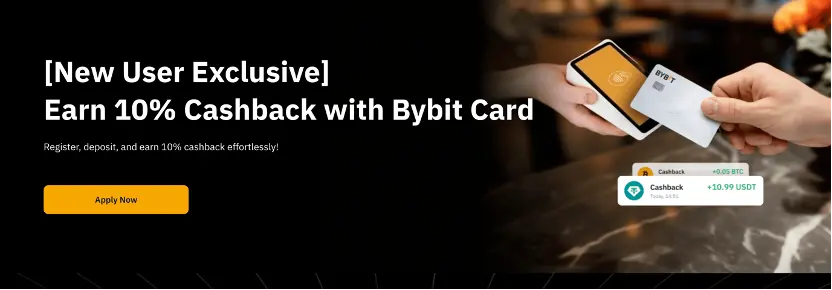
It is important to note that consumption in different regions may incur additional currency conversion fees. For example, if a user makes a card payment in a merchant using Japanese Yen, the final fee may include the exchange rate from USD/Euro to Yen, which the user will also need to bear. Overall, this card has a clear advantage in usability due to its connection to the exchange, making it one of the more convenient options in the current market.
Bitget Card: Exclusive Payment Card for VIPs
Compared to traditional bank cards, Bitget's virtual debit card also highlights "no annual fee" and "direct consumption of USDT" as its main selling points, attracting considerable attention from crypto users. This card currently supports two card organization options: UnionPay and Mastercard, covering actual needs in different regions and consumption scenarios.
The issuer of the Bitget card is DCS (DeCard), a locally regulated issuing bank in Singapore, which has reportedly been acquired by Bitget for a majority stake. Although DeCard also offers card application services for individual users, this path typically requires applicants to have local identity verification and a phone number in Singapore, making it a higher threshold. Therefore, applying through the Bitget platform is a more feasible option.
It is important to note that the Bitget card is currently not open for application to all users. According to the platform's current rules, only users who reach VIP status are eligible to apply, with one common threshold being that the account balance must reach 30,000 USDT or equivalent assets. Therefore, the target user group for this card is more focused on high-net-worth or active trading users.
Currently, the Bitget card also supports binding operations with Apple Pay, Google Pay, Alipay, WeChat, etc., focusing on the liquidity release of on-chain assets combined with daily consumption. It should be noted that different types of Bitget cards exist; the Bitget card on the official website is a Visa card with USD as the underlying settlement currency, while the popular Bitget premium payment card on Twitter is a Mastercard/UnionPay card with Singapore Dollar as the underlying settlement currency, which is slightly different. According to user experiences on Twitter, this card can be used smoothly in all places that support Mastercard.
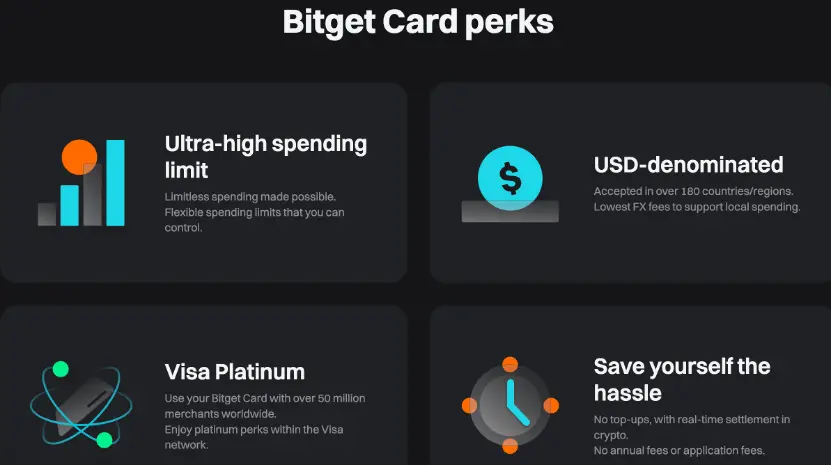 Additionally, Bitget has stated on its homepage that there will be opportunities for BGB cashback in the future.
Additionally, Bitget has stated on its homepage that there will be opportunities for BGB cashback in the future.
In terms of fees, the transaction fees for the Bitget card also range from 0.9% to 3%, mainly influenced by the transaction currency, consumption location, and whether currency conversion is involved. For example, if a transaction settled in USDT is made in a region that does not use USD/Singapore Dollar, certain currency conversion fees may be triggered. Additionally, different payment channels (such as UnionPay and Mastercard) may also affect the settlement time and intermediary fees. At the same time, Alipay and WeChat Pay will charge fees for transactions exceeding 300 yuan.
Overall, the Bitget card, as a virtual financial product derived from the exchange, provides users with another channel to use crypto assets for real-world consumption, especially suitable for users with larger asset scales and frequent cross-border consumption.
SafePal x Fiat24: More than Just a U Card, but a Compliant Bank Account
Unlike the traditional concept of a "virtual card," SafePal offers a more integrated crypto financial service, supported by the Swiss-registered bank Fiat24. After completing identity verification and address validation, users will receive a real European bank account (including IBAN), which can be used for international receipts, withdrawals, and even consumption with the associated debit card.
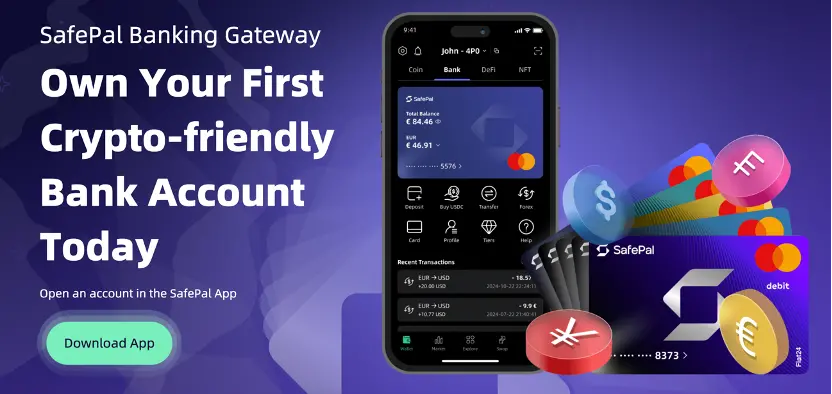
The application process is slightly more complex compared to other cards. Users need to first enter the relevant module within the SafePal wallet interface, provided that the account's region supports this service (currently including mainland China). Next, users need to transfer a small amount of ETH on the Arbitrum network to mint an identity NFT, which is a necessary credential to access Fiat24 banking services. After completing KYC and address verification, the system will assign a Fiat24 bank account, and users can simultaneously apply for a Mastercard debit card linked to the account. In 2023, some users received Visa cards, but the mainstream version is Mastercard.
This card also supports binding with Apple Pay, Google Pay, Alipay, and WeChat Pay, etc., with underlying settlement currencies supporting Euro, USD, Swiss Franc, and RMB.
In terms of fees, the comprehensive fee range for the SafePal debit card is 1% to 3%, depending on the specific transaction structure. The account withdrawal fee is about 1%, while transactions in the same currency do not incur additional charges, which is good news for users with consumption needs in the above four currencies. Once the fiat currency balance in the bank card is exhausted, the system will automatically deduct from the linked crypto asset balance for consumption.
Additionally, since users receive a complete bank account, this account supports international transfers to major banks, as well as to international digital banks like ifast, Wise, Revolut, and there are many experiments and fee evaluations shared on social media.
Compared to other exchange-dominated card products, the collaboration between SafePal and Fiat24 is closer to the extension of traditional financial services into the crypto world. It provides users with not just a card, but a complete financial account that can freely receive and send Euros, associate with crypto assets, and has a compliant identity label, especially suitable for users with cross-border income and expenditure needs or asset export requirements.
Morph Black Card: The "Leader" in High-End Credit Cards
The Morph Black Card is a flagship membership rights carrier launched by Morph, positioned as a "combination product of on-chain identity + real-world privileges" for high-net-worth crypto users. Unlike traditional virtual debit cards, the application threshold for the Morph Black Card is to hold a specific NFT—Morph Black NFT, which currently has a floor price of about 0.87 ETH in the secondary market. This NFT not only symbolizes the user's membership identity but also embeds the pricing and circulation functions of on-chain financial rights.
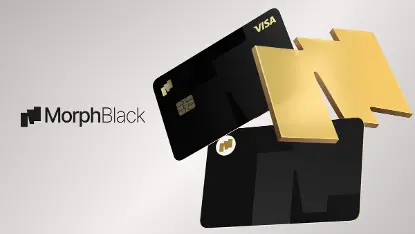
In terms of functional design, the Morph Black NFT is officially defined as the flagship asset of the MorphPay ecosystem, and its holders may receive future Morph Token airdrops, enjoying allocation rights during the minimum fully diluted valuation (FDV) phase. At the same time, the NFT will link to multiple ecosystem projects, including the BAI Fund, to bring airdrop incentives to users. Cardholders can also participate in the platform's on-chain deposits, earning annualized returns of up to 30%.
In terms of card benefits, the Morph Black Card is a 22g physical black gold card. After completing KYC, cardholders can apply for this card, with advertised benefits including the waiver of the common annual fee of about $300 for traditional black cards, and enjoying transaction fees as low as 0.3% during deposit and withdrawal processes (depending on currency exchange needs). The card has a daily deposit and withdrawal limit of up to $1 million and will also come with a Singapore dollar bank account. Additionally, according to publicly available information from the platform and community discussions, the card will also connect with hotels, flight bookings, and private concierge services worldwide, potentially supported by the Aspire VIP system, creating travel and lifestyle services for crypto asset holders similar to traditional high-end credit cards.
Furthermore, according to community and social media reports, the Morph Black physical card may be built on the DCS (DeCard) issuance system, with its backer Bitget reportedly having acquired a majority stake in DCS. Therefore, this card is likely developed based on DCS's Mastercard card, and some benefits may come from the DCS black card, the Imperium World Elite Card, and it may feature a credit card mechanism.
The Morph team has stated that they will launch a regular card version aimed at a broader user base in the future to expand its payment network and ecosystem penetration. Overall, the Morph Black Card is one of the most "high-end financial" symbolic card products currently on the market, suitable for seasoned crypto users seeking asset exclusivity and combinable benefits.
It is worth mentioning that Morph just started selling the Morph Platinum SBT a few days ago. By minting the Morph Platinum SBT, users can secure their quota rights in the ecosystem under a $50 billion FDV and unlock 50% of the tokens at TGE. At the same time, SBT holders will receive the Morph Platinum Card, details of which have not yet been disclosed, but it is also a U card that supports direct consumption of cryptocurrencies, offering a one-year trial of black card benefits valued at $300. Currently, the minting fee for the Morph Platinum SBT is 0.3 ETH.
Infini Card: Virtual Card Supporting OnlyFans
Infini has three different cards: Meow Card and Rabbit Card are core virtual card products that provide flexible on-chain payment and daily consumption solutions for different user needs. Currently, both cards are sold at a price of $9.9, with no annual or monthly fees, and support binding with Alipay and WeChat Pay, making them one of the few overseas virtual card products compatible with mainstream payment tools for Chinese users.
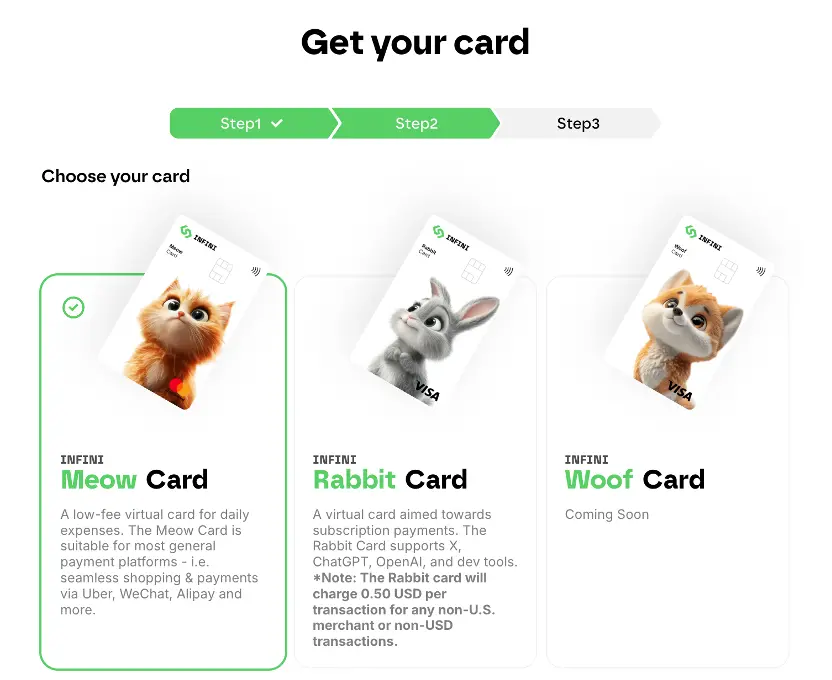
The Meow Card belongs to the Mastercard network, making it more suitable for daily consumption scenarios priced in RMB, with a transaction service fee of 0.8% of each consumption amount. When making payments in non-USD currencies, the system will automatically perform currency conversion, charging a cross-border fee of 1% to 1.5%, with a minimum of $0.01.
The Rabbit Card, on the other hand, uses the Visa network, focusing more on USD merchants, especially suitable for a range of subscription platforms, including ChatGPT Plus, OpenAI API, Midjourney, Cursor, AWS, Google Cloud, Notion, GoDaddy, GitHub, and mainstream consumption platforms like Netflix, YouTube, eBay, and Amazon, essentially covering all daily USD subscription services.** The basic service fee for the Rabbit Card is also 0.8% per transaction, but its fees for non-US merchants or non-USD transactions are a fixed 1% plus $0.50, with a minimum fee threshold of $0.01.
Of course, the Infini official website kindly indicates to users that both the Meow Card and Rabbit Card support subscriptions to OnlyFans, truly addressing user needs.
Although both cards are virtual, they can be quickly linked to Alipay and WeChat Pay in actual use, achieving a seamless payment experience. The official website shows that Infini's physical card product, the Woof Card, is in preparation, which will support Apple Pay and Google Pay in the future and have broader offline payment capabilities, expected to further expand the user base.
Welfare Cards for Overseas Residents: No-Fee Cards, Cashback Cards, "Lending" Cards
Note: All KYC requirements below are for "residents" and are not limited to nationality. That is, residents who can provide proof of local residence, such as utility bills and credit card statements, will have varying KYC difficulties depending on the requirements of different issuers.
Coinbase Card: The Only "No-Fee, No-Loss" Payment U Card
As one of the largest and most compliant cryptocurrency trading platforms globally, the debit card launched by Coinbase has significant advantages in user trust and fund security. This card is issued to users with Coinbase accounts, particularly suitable for residents in the United States or the European Economic Area (EEA). Applicants must have legal residency status and a real residential address in their location, and KYC review is not supported for mainland China.
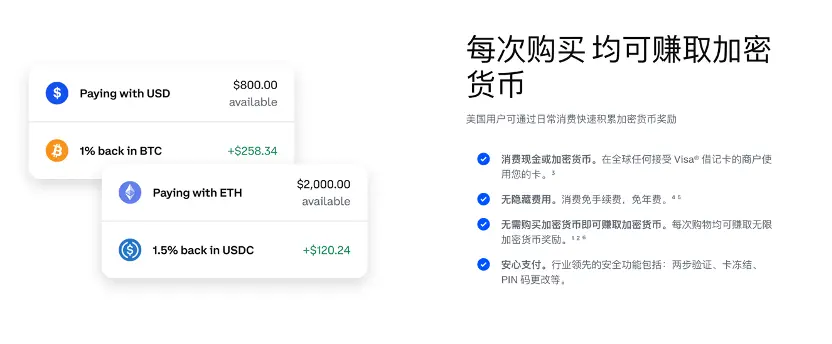
However, strict KYC brings high-end benefits: one of the biggest features of the Coinbase debit card is the waiver of all fees; its "native asset payment" mechanism allows users to directly use stablecoins like USDC for daily consumption. The platform also supports fee-free conversion of fiat currency to USDC, which significantly reduces the asset conversion costs for cardholders. Daily transactions and ATM withdrawals are also typically fee-free, providing users with an almost lossless payment experience. Additionally, the card is a VISA debit card, which can be used normally at merchants and services worldwide that support this network, covering a wide range of scenarios.
When users withdraw funds from Coinbase to their local bank accounts, if the account is located in a country or region supported by Coinbase, it can usually achieve quick arrival, and the entire process is widely regarded as "smooth and stable." Furthermore, Coinbase occasionally launches cashback activities for debit card users, although the frequency is not high, it serves as an additional incentive for long-term cardholders.
Overall, the Coinbase debit card, due to its compliant background, low fee structure, and good fiat deposit and withdrawal experience, has become one of the most popular crypto debit cards among users in Europe and the United States. For users already managing assets on the Coinbase platform, this card is undoubtedly an ideal extension of their on-chain asset daily usage scenarios.
Nexo Card: Cashback Credit Card for Residents in Europe
The Nexo Card is launched by Nexo, a crypto trading platform headquartered in France with compliance licenses in the EU and the UK, and is only open to residents of the European Economic Area (EEA) and the UK. Holders of Chinese passports need proof of address and a residence card in Europe to open an account. This card not only supports consumption of crypto assets but is also one of the few true "credit card model" U cards, allowing users to pay first and repay later, and it supports considerable cashback rates, making it one of the few cards that can compete with North American credit cards.
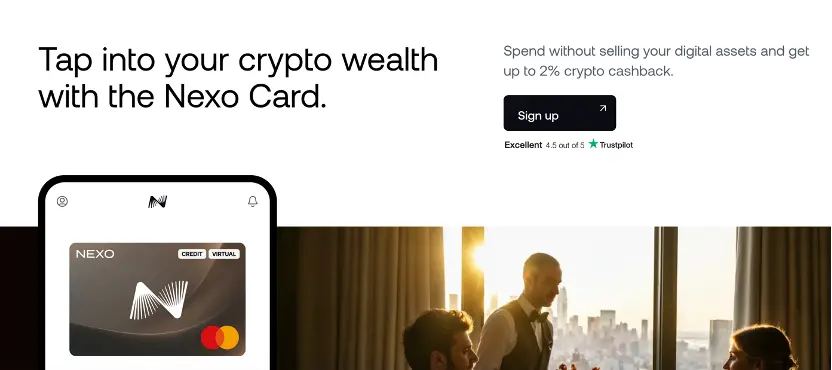
The Nexo Card belongs to the Mastercard network and can be used at almost all merchants within the network.
The cashback mechanism of the Nexo Card adopts a dynamic reward model based on user asset allocation. All daily consumption can earn cryptocurrency cashback, with a base cashback of 0.5% of the consumption amount, and the payment currency can be flexibly chosen between NEXO Token or Bitcoin (BTC) on the platform. When the total amount of crypto assets held in the user's account exceeds $5,000, they will automatically be included in the Loyalty Program and classified into different loyalty levels based on the proportion of NEXO tokens in their asset portfolio, thus receiving higher cashback incentives.
Specifically, the highest platinum-level users can receive up to 2% cashback in NEXO tokens or choose to receive BTC at a rate of 0.5%; gold-level users receive 1% and 0.3%; silver-level users receive 0.7% and 0.2%; while the base level remains at 0.5% NEXO or 0.1% BTC cashback. This tiered reward mechanism encourages users to hold more NEXO tokens on the platform, thereby enhancing user stickiness and the intrinsic value support of the platform's tokens.
In terms of fees, the Nexo Card has no annual or monthly fees, and the foreign exchange conversion fee structure is also relatively transparent, but it differs from traditional conversion rate designs. If the trading currency is the same as the card's default currency (Euro or GBP), there are no fees; for transactions where the card currency (Euro or GBP) differs from the merchant's local currency, i.e., foreign currency transactions, the system will convert the transaction amount. If the transaction is settled in Euro, Swiss Franc, or GBP, the currency conversion fee is only 0.2%; while for currencies from other countries or regions, the rate is 2%. Additionally, all foreign currency transactions conducted on weekends will incur an extra 0.5% fee, which is somewhat peculiar.
Combining its credit payment capabilities, dynamic cashback system, and crypto asset-oriented membership model, the Nexo Card establishes a relatively mature bridge between traditional financial systems and crypto asset usage scenarios, suitable for users residing in Europe who require cashback.
RedotPay (Little Red Card): A Payment-Friendly Solution for Hong Kong, Macau, and Taiwan
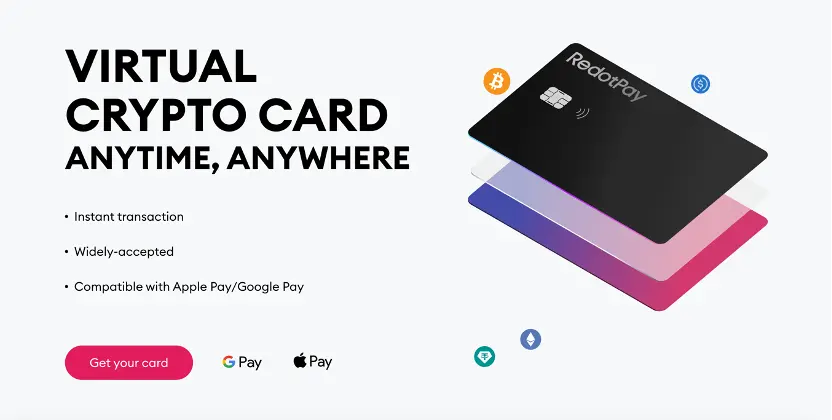
RedotPay is a crypto payment company headquartered in Hong Kong, officially launching its cryptocurrency payment card at the end of 2023, aimed at meeting users' convenient needs for using crypto assets in real-world scenarios. The card is primarily positioned similarly to traditional debit cards, where the system directly deducts the equivalent amount of cryptocurrency from the user's linked account to pay for purchases, eliminating the need to pre-load funds into a fiat account and not involving credit loan features. Unlike previously introduced card products from exchanges, RedotPay is not a virtual currency exchange but focuses on providing blockchain-based payment solutions, thus its card products are more centered on the usage path of on-chain assets themselves.
Currently, the card does not support registration and use for residents of mainland China but can be applied for and used in several overseas regions. The overall fee structure is at a moderate level, with comprehensive fees ranging from 1% to 3%, depending on currency conversion and consumption scenarios. A major highlight of the RedotPay card is its direct support for Binance Pay, allowing users to recharge and settle through the Binance wallet system, giving it a certain advantage in terms of interoperability within the on-chain ecosystem.
In terms of card type, RedotPay offers a VISA card, which is relatively rare in the crypto card market. Additionally, the card waives annual fees, reducing long-term holding costs for users, but a one-time fee of $100 is required for the application of the physical card.
Regarding rates, RedotPay provides a complete fee schedule:
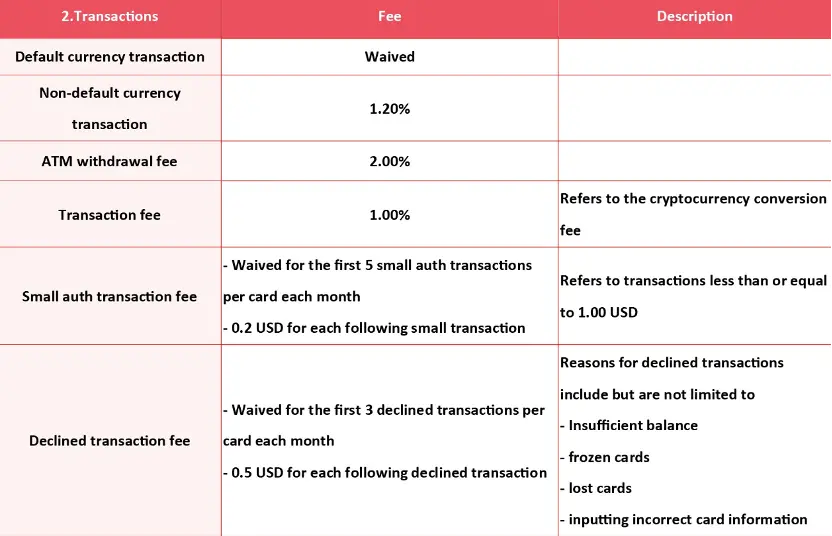
Here, it can be seen that the transaction fee for non-default underlying currencies is 1.2%, ATM withdrawal fees are 2%, and transaction fees are 1%. These fees do not include charges from transaction platforms (such as Alipay).
Overall, the RedotPay crypto card targets overseas users with cross-border living or online consumption needs, suitable for those who wish to use on-chain assets directly for daily payments without relying on centralized exchanges for asset custody. It is one of the few representative products in the current crypto card market that follows a "light platform" approach.
Decentralized Project U Card Series, Focused on Self-Custody Funds
MetaMask Card: A Low-Fee Payment Card Launched by MetaMask
The MetaMask Card is a lightweight crypto payment tool launched by the crypto wallet giant MetaMask, primarily aimed at existing wallet users, intending to extend on-chain funds directly into daily consumption scenarios. The card is currently in an early open phase, with registration available only to residents of certain countries and regions, including the United States (excluding New York and Vermont), the UK, EU member states, Switzerland, Mexico, Colombia, and Brazil. Its global version has not yet been fully opened.
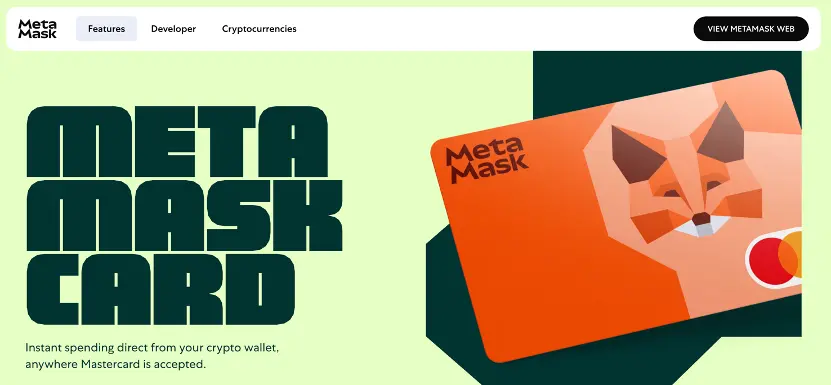
The MetaMask card also belongs to the Mastercard merchant network. It is reported that a physical metal card will be available as an airdrop benefit in the future.
In terms of asset support, the MetaMask Card currently supports USDC, USDT, and wETH, with all funds required to be stored on the Linea network. Users need to cross-chain the relevant assets to recharge on that chain. After recharging, the card can be directly connected to Apple Pay or Google Pay for mobile payments, allowing use without a physical card. During use, the system will real-time convert the selected crypto asset into fiat currency for each purchase, settling in the local currency, with the conversion process completed instantly when the transaction is initiated.
Regarding fees, when using stablecoins like USDC or USDT for payments, only the gas fee for the Linea network needs to be borne, typically around $0.02; if using non-stablecoins like wETH, an additional 0.875% on-chain swap fee is required. All fees will be displayed in the card's backend "Manage" module after the transaction is completed, allowing users to view detailed bills, including exchange rates, deducted amounts, and fees.
Additionally, the MetaMask Card offers a 1% cashback in USDC for all purchases, further enhancing the cost-effectiveness of users directly consuming on-chain assets. This cashback model and the visualized fee structure make the card very suitable for users familiar with DeFi and on-chain operations, especially those who have already made the MetaMask wallet their primary asset management tool.
1inch Card: A Magical "Lending" Card Allowing Collateralized Borrowing of Stablecoins for Consumption
The 1inch Card, launched by the crypto aggregation trading platform 1inch, is supported by Crypto Life and uses Baanx as the compliance deposit and withdrawal service provider. This card not only possesses conventional on-chain payment capabilities but also provides users with more strategic asset consumption options through a "collateral + lending" model. In terms of identity verification, the KYC process required for the 1inch Card is similar to other products under the Baanx ecosystem, primarily open to compliant residents of the European Economic Area and the UK, requiring local proof of address.
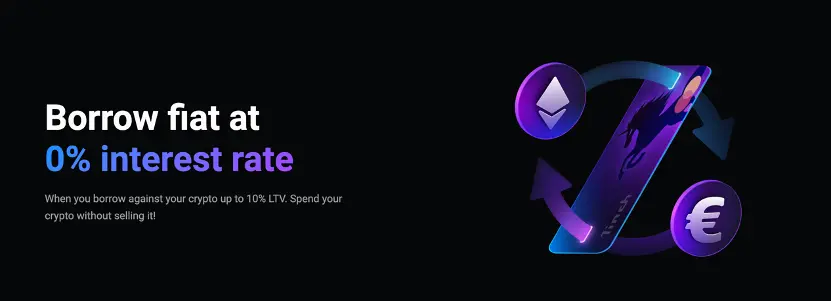
Unlike most crypto cards that directly consume on-chain assets, the 1inch Card allows users to use BTC or ETH as collateral to borrow stablecoins for daily consumption. Users can choose USDC, USDT, or EURT as the borrowing currency and can set the loan period between 6, 12, 18, or 24 months. This lending model is particularly friendly to users who are bullish on crypto assets in the long term. For example, when Bitcoin prices are low, users can borrow stablecoins for consumption by collateralizing BTC, without directly spending their Bitcoin. When BTC prices rise, users can choose to repay the stablecoins, thus redeeming their original assets at a higher value. This mechanism not only preserves the future growth potential of the assets but also meets real liquidity needs.
Of course, borrowing stablecoins will incur interest, but as long as the appreciation of the collateralized assets can cover this interest, the advantages of the lending card become very apparent. According to the official website, during the borrowing period, the interest portion must be automatically repaid monthly, with the deduction operation completed automatically through the system's stablecoin wallet. Once the loan and interest are fully repaid, users will receive all collateralized assets back in their original form.
At the same time, the platform supports users in obtaining a credit limit of up to 60% of the value of their collateralized assets.
In terms of payment currencies, the 1inch Card supports mainstream Layer 1 assets such as BTC, ETH, LTC, and XRP, but does not currently support Layer 2 network assets. When users make purchases, the system will automatically convert to fiat currency and complete the settlement. The platform's fee structure is relatively complex but clear: the card consumption fee is 2%, the exchange between cryptocurrencies and the conversion of crypto to fiat are both 1.75%; if withdrawing crypto assets, the fee is between 0.4% and 0.5%; withdrawing fiat through bank transfer incurs a fee of 3.49%. In terms of card services, there are no annual or maintenance fees, but withdrawing GBP incurs a fee of €2.50, while withdrawing foreign currency incurs a fee of €3.00 plus 1.5%.
These fees may seem high, but they do not stack. This means that direct card consumption incurs a 2% fee plus potential foreign exchange conversion costs, and after converting to fiat at a rate of 1.75%, users can directly consume in fiat, overall not significantly different from other crypto assets.
Additionally, the 1inch Card offers a 2% crypto cashback for each purchase, further enhancing the cost-effectiveness of daily use. Combining its collateral-based stablecoin lending capability, flexible term settings, and wide range of supported asset types, the 1inch Card is not just a consumption card but also a micro-financial toolkit for crypto asset holders, occupying a unique position in the increasingly integrated DeFi and real financial scenarios.
免责声明:本文章仅代表作者个人观点,不代表本平台的立场和观点。本文章仅供信息分享,不构成对任何人的任何投资建议。用户与作者之间的任何争议,与本平台无关。如网页中刊载的文章或图片涉及侵权,请提供相关的权利证明和身份证明发送邮件到support@aicoin.com,本平台相关工作人员将会进行核查。




